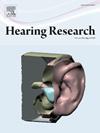Silicone-based AC102-loaded cochlear implant coatings protect residual hearing in an animal model of cochlear implantation
IF 2.5
2区 医学
Q1 AUDIOLOGY & SPEECH-LANGUAGE PATHOLOGY
引用次数: 0
Abstract
Cochlear implant users with residual hearing benefit synergistically from combined electrical stimulation via the cochlear implant and preserved residual hearing after surgery. However, direct mechanical trauma and subsequent inflammation may deteriorate hearing function. AC102, a novel otoprotective pyridoindole with anti-apoptotic and anti-oxidative properties significantly improved hearing recovery following cochlear implantation when administered intratympanically prior to surgery. Additionally, AC102 exerts neurotrophic effects, possibly aiding in the preservation of auditory nerve fibers and spiral ganglion neurons. Rapid clearance of the drug, however, might be a limiting factor to further attenuate the inflammatory response and maintain neuronal health. The aim of the current study was to design an AC102-loaded electrode array for sustained drug delivery and investigate its effects in hearing preservation cochlear implantation.
First, the release-kinetics of AC102 were investigated in vitro and modelled by the Higuchi equation of drug release. An electrode array coated with 10 % AC102 was manufactured, its release kinetics evaluated, and subsequently tested in vivo. 20 normal hearing Mongolian gerbils were unilaterally implanted with an AC102-loaded or an unloaded control electrode. Compound action potentials were measured prior to cochlear implantation and serially over 28 days. Hair cells, inner hair cell synapses, and auditory nerve fibers were quantified in cochlear whole-mounts by immunofluorescence staining.
AC102 release from silicone coating could be predictably modelled by the Higuchi equation of drug release. The electrode array with an AC102-silicone depot enabled non-linear sustained drug release with initially higher release concentrations. In vivo, the AC102-loaded electrode array significantly recovered auditory threshold shifts near the maximum insertion depth over 28 days. In the apical region, a significant recovery was noticed only until day 14, after which threshold shifts aligned between groups. Histologically, AC102-loaded electrodes significantly preserved outer hair cells apical of the maximum insertion depth and inner hair cells and neuronal structures at the tip of the inserted electrode.
In conclusion, the drug-loaded electrode arrays could predictably release AC102 over a period of 28 days. AC102 enabled the restoration of auditory thresholds near the area of maximum insertion, which is the desired region to be preserved in cochlear implant recipients with residual hearing.
硅基 AC102- 人工耳蜗涂层可保护人工耳蜗植入动物模型的残余听力。
人工耳蜗植入者术后通过人工耳蜗进行电刺激并保留残余听力,可使残余听力者协同受益。然而,直接的机械创伤和随后的炎症可能会恶化听力功能。AC102是一种新型耳保护性吡啶吲哚,具有抗凋亡和抗氧化特性,在人工耳蜗植入手术前进行耳内给药,可显著改善术后听力恢复。此外,AC102 还具有神经营养作用,可能有助于保护听神经纤维和螺旋神经节神经元。然而,药物的快速清除可能是进一步减轻炎症反应和维持神经元健康的限制因素。本研究的目的是设计一种用于持续给药的 AC102 负载电极阵列,并研究其在听力保护人工耳蜗植入中的效果。首先,在体外研究了 AC102 的释放动力学,并用药物释放的樋口方程建立了模型。制作了涂有 10% AC102 的电极阵列,评估了其释放动力学,随后进行了体内测试。20 只听力正常的蒙古沙鼠单侧植入了一个涂有 AC102 的电极或一个未涂 AC102 的对照电极。在人工耳蜗植入前和 28 天内连续测量复合动作电位。通过免疫荧光染色对耳蜗全切片中的毛细胞、内毛细胞突触和听神经纤维进行量化。硅涂层中 AC102 的释放可以用药物释放的樋口方程来预测。带有 AC102 硅涂层的电极阵列可实现非线性的持续药物释放,最初的释放浓度较高。在体内,负载 AC102 的电极阵列在 28 天内显著恢复了最大插入深度附近的听觉阈值偏移。在顶端区域,仅在第 14 天之前有明显恢复,之后各组之间的阈值偏移趋于一致。从组织学角度来看,AC102 负载电极可显著保留最大插入深度顶端的外毛细胞以及插入电极顶端的内毛细胞和神经元结构。总之,载药电极阵列可预测地在28天内释放AC102。AC102 能够恢复最大插入区域附近的听觉阈值,而这正是有残余听力的人工耳蜗植入者希望保留的区域。
本文章由计算机程序翻译,如有差异,请以英文原文为准。
求助全文
约1分钟内获得全文
求助全文
来源期刊

Hearing Research
医学-耳鼻喉科学
CiteScore
5.30
自引率
14.30%
发文量
163
审稿时长
75 days
期刊介绍:
The aim of the journal is to provide a forum for papers concerned with basic peripheral and central auditory mechanisms. Emphasis is on experimental and clinical studies, but theoretical and methodological papers will also be considered. The journal publishes original research papers, review and mini- review articles, rapid communications, method/protocol and perspective articles.
Papers submitted should deal with auditory anatomy, physiology, psychophysics, imaging, modeling and behavioural studies in animals and humans, as well as hearing aids and cochlear implants. Papers dealing with the vestibular system are also considered for publication. Papers on comparative aspects of hearing and on effects of drugs and environmental contaminants on hearing function will also be considered. Clinical papers will be accepted when they contribute to the understanding of normal and pathological hearing functions.
 求助内容:
求助内容: 应助结果提醒方式:
应助结果提醒方式:


